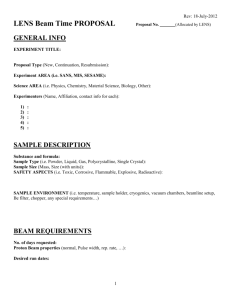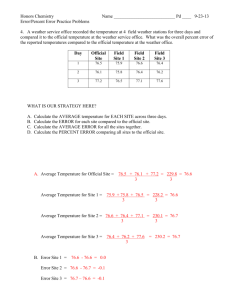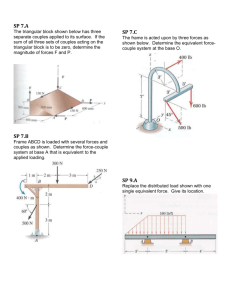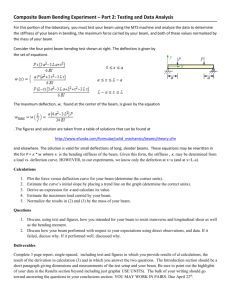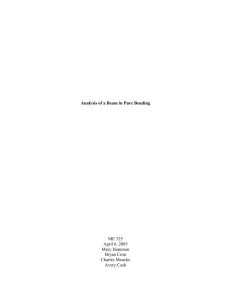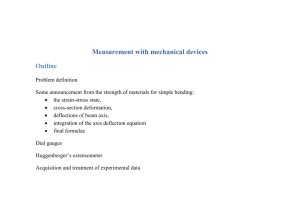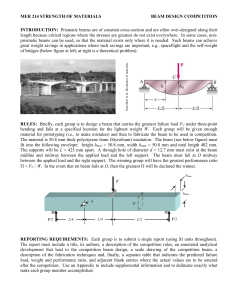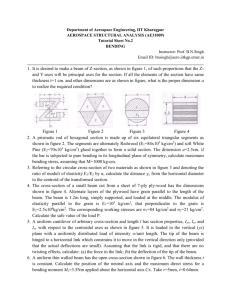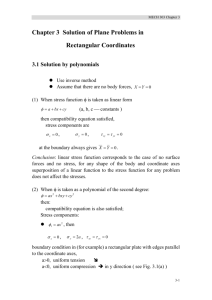L-3
advertisement
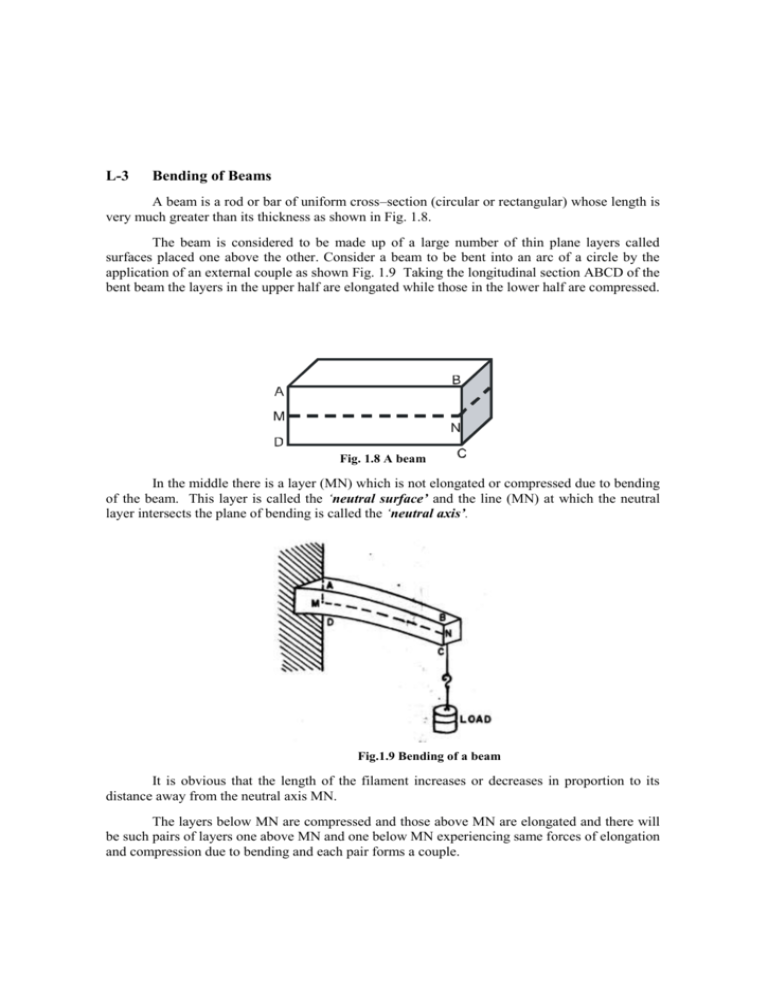
L-3 Bending of Beams A beam is a rod or bar of uniform cross–section (circular or rectangular) whose length is very much greater than its thickness as shown in Fig. 1.8. The beam is considered to be made up of a large number of thin plane layers called surfaces placed one above the other. Consider a beam to be bent into an arc of a circle by the application of an external couple as shown Fig. 1.9 Taking the longitudinal section ABCD of the bent beam the layers in the upper half are elongated while those in the lower half are compressed. Fig. 1.8 A beam In the middle there is a layer (MN) which is not elongated or compressed due to bending of the beam. This layer is called the ‘neutral surface’ and the line (MN) at which the neutral layer intersects the plane of bending is called the ‘neutral axis’. Fig.1.9 Bending of a beam It is obvious that the length of the filament increases or decreases in proportion to its distance away from the neutral axis MN. The layers below MN are compressed and those above MN are elongated and there will be such pairs of layers one above MN and one below MN experiencing same forces of elongation and compression due to bending and each pair forms a couple. Properties of Matter and Sound 1.2 The resultant of the moments of all these internal couples are called the internal bending moment and in the equilibrium condition, this is equal to the external bending moment. 1.12 Bending Moment of a Beam Consider the section PBCP’ (Fig. 1.10), the extended filaments lying above the neutral axis MN are in state of tension and exert an inward pull on the filament adjacent to them towards the fixed end of the beam. In the same way the shortened filaments lying below the neutral axis MN are in a state of compression and exert an outward push on the filaments adjacent to them towards the loaded end of the beam. As a result tensile and compressive stresses develop in the upper and lower halves of the beam respectively and form a couple which opposes to bending of the beam. The moment of this couple is called the moment of the resistance. When the beam is in equilibrium position the bending moment and restoring moment or moment of resistance should be equal. To find an expression for the moment of the restoring couple consider a fiber DC at a distance r from the neutral axis MN as shown in Fig.1.11. Let the radius of curvature be R and ф be the angle subtended by it at the centre of curvature. In unstrained position of the beam, the length of the fiber DC = MN = Rф. In the strained position the length of the fibre, DC = (R + r) ф. P A M B P’ D N C Load Fig. 1.10 Calculation of bending moment of a beam A B M N C D ф Fig.1.11 Strained position Properties of Matter and Sound Strain in the fiber DC, = or Strain 1.3 Change in the length Original length (R r) R r R R (1) i.e., strain is proportional to the distance from the neutral axis. Let the area of the fiber be A and its neutral axis be at a distance r from neutral axis of the beam and the strain produced be r/R. We have Stress = Y x Strain = Y r / R (2) Hence, force on the area A F = Y(r/R) x A (3) Therefore the moment of this force about MN = Y(r/R) x A x r = Y A r2 / R (4) As the moment of the forces acting on both the upper and lower halves of the section are in the same direction, the total moment of the forces acting on the filaments due to straining Y ar2 Y Y ar 2 I g R R R (5) where Ig is the geometrical moment of inertia and is equal to AK2, A beding the total area of the section and K being the radius of gyration of the beam :. moment of the forces Y Ig R (6) In equilibrium bending moment of the beam is equal and opposite to the moment of bending couple due to the load on one end. :. Bending moment of the beam = Y Ig R (7) The quantity YIg (=Y A K2) is called the flexural rigidity of the beam. Flexural rigidity is defined as the bending moment required to produce a unit radius of curvature. 1.13 Uniform Bending The beam is loaded uniformly on its both ends, the bent beam forms an arc of a circle. The elevation in the beam is produced. This bending is called uniform bending. Properties of Matter and Sound 1.4 Consider a beam (or bar) AB arranged horizontally on two knife – edges C and D symmetrically so that AC = BD = a as shown in Fig. 1.12 Fig. 1.12 Uniform Bending The beam is loaded with equal weights W and W at the ends A and B. The reactions on the knife edges at C and D are equal to W and W acting vertical upwards. The external bending moment on the part AF of the beam is = W x AF – W x CF = W (AF – CF) = W x AC = W x a Internal bending moment = (1) YI g R (2) where Y - Youngs’ modulus of the material of the bar Ig - Geometrical moment of inertia of the cross-section of beam R - Radius of curvature of the bar at F In the equilibrium position, external bending moment = internal bending moment Wa YI g R (3) Since for a given value of W, the values of a, Y and Ig are constants, R is constant so that the beam is bent uniformly into an arc of a circle of radius R. CD = l and y is the elevation of the midpoint E of the beam so that y = EF Then from the property of the circle as shown in Fig. 1.13 Properties of Matter and Sound F C F 1.5 y C D l/2 E O R Fig. 1.13 Circle Property EF (2R – EF) = (CE)2 (4) l 2 y (2R – y) = 2 y 2R = y= or l2 ( y2 is negligible) 4 (6) l2 8R (7) 1 8y R l2 From (3) and (8), Wa = or (5) Y (8) 8y YI g 2 W l2 a 8I g y If the beam is of rectangular cross-section, I g (9) bd 3 , where b is the breath and d is the 12 thickness of beam. If M is the mass, the corresponding weight W = Mg Properties of Matter and Sound Hence Y 3 Mgl 2 a 2 bd 3 y 1.6 (10) from which Y the Young’s modulus of the material of the bar is determined. Experiment A rectangular beam (or bar) AB of uniform – section is supported horizontally on two knife – edges A and B as shown in Fig. 1.14 Fig. 1.14 Uniform bending experiment Two weight hangers of equal masses are suspended from the ands of the beam. A pin is arranged vertically at the mid-point of the beam. A microscope is focused on the tip of the pin. Initial reading of the microscope in the vertical scale is noted. Equal weights are added to both hangers simultaneously and the reading of the microscope in the vertical scale in noted. The experiment is repeated for decreasing order of magnitude of the equal masses. The observations are then tabulated and the mean elevation (y) at the mid point of the bar is determined. Table 1.3 Uniform bending experimental observation Microscope reading elevation Mean elevation(y) for Load in Kg Load increasing W W+50 gms W+100 gms W+150 gms W+200 gms W+250 gms Load decreasing Mean a load of M. Properties of Matter and Sound 1.7 The length of the bar between the knife edges ‘l’ is measured. The distance of one of the weight hangers from the nearest knife edge p is measured. The breadth (b) and thickness (d) of the bar are measured using vernier calipers and screw gauge. The young’s modulus of the material of the beam is determined by the relation Y 3 M g al2 2 bd 3 y Nm-2 Worked Example 1.11: Uniform rectangular bar 1 m long 2 cm broad and 0.5 cm thick is supported on its flat face symmetrically on two knife edges 70 cm apart. If loads of 200 g are hung from the two ends, find the elevation at the center of the bar. Young’s modulus of the material of the bar is 18 x 1010 Pa. The distance between the nearer knife edge and the point of suspension a=15x10-2 m Elevation at the centre, y 3 M g al2 2 Yb d 3 3 200 10 3 9.8 15 10 2 0.7 2 2 18 1010 2 10 2 (0.5 10 2 ) 3 = 4.802 x 10-4 m
